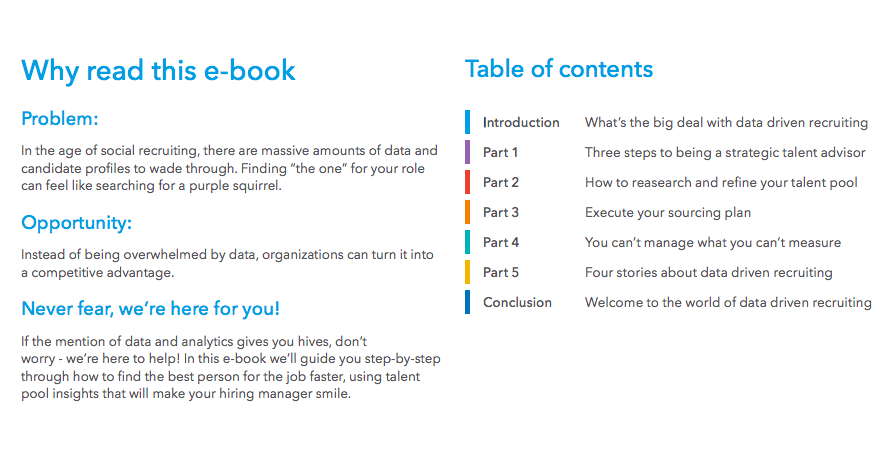One of the most common challenges that marketers face is producing consistent, quality content at scale. We’ve struggled with this problem ourselves, as have our clients. But here’s one thing we know for sure: No matter what your marketing operation looks like, if there’s a chance to work smarter, not harder, you take it. That’s why we’re excited to share today’s marketing hack to maximize your content.
Whether you’re a scrappy startup or a flourishing Fortune 500, today we’ll walk you through the simple process we use to create large batches of custom-tailored content for multiple campaigns—without wasting more time, money, or energy.

Divisible Content: The Key to Easy Marketing Campaigns
Content marketing isn’t easy. It takes a lot of work (and, often, people) to create one good piece of content. Unfortunately, many marketers are facing budget cuts across the board, making it harder to do even the minimum.
67% of marketers say they’ve been asked to do more with the same resources.
—2022 Content Marketing Institute’s B2B Content Marketing Report
Good content marketing is all about creating consistent, quality work that tells a cohesive brand story. But without much support, it’s tough to create that steady stream of content. And even when you have the budget, it can be tough to ensure your work tells a consistent story, especially if you’re using freelancers. (In fact, churning out piecemeal content that doesn’t support a larger narrative is one of the most common mistakes we see marketers make.)
Of course, at the end of the day, it’s quality that matters over quantity. So when resources are lacking, you need to be more intentional about getting the most mileage out of every piece of content you create. How do you do that? Try a divisible content strategy.
A divisible content strategy is an approach to content creation in which you create a single cornerstone piece of content, then spin that single asset into multiple pieces of content. (Note: That cornerstone piece of content is usually something meaty, such as a guide or ebook.)

This tactic helps you…
- Increase the volume of content you create. Maintaining a steady publishing cadence is crucial, but what do you do if you don’t have enough content to fill your queue? A divisible content strategy makes it easier to create a batch of content without having to start from scratch.
- Mix up the type of content you create. It’s easy to get stuck on autopilot, generating the same type of content over and over. But your audience is likely spread across different channels, and each channel requires its own type of content. (This is especially true on social media, where native content is becoming the norm as algorithms bury anything that links away from the platform.) From infographics to data visualizations, articles to presentations, a divisible strategy lets you experiment with different formats to maximize your touchpoints and run multiple campaigns.
- Target different audiences. You likely have several different audiences that are interested in your content. By creating multiple pieces to promo your main piece, you can tailor your messaging to engage those different audiences across different platforms—again, without having to create net new content. As all of this teaser content links back to the core piece of content, you can easily increase your reach and build brand awareness.
- Maintain a cohesive brand story. It can be tough to maintain a narrative through-line for all of your content, but to tell your brand story effectively, you need to be consistent in everything from the way you look to the way you talk about your brand. Creating content this way ensures each piece is on brand and on message.
Here, we’ll guide you through our step-by-step process to create divisible content—and keep your editorial calendar full for months.
1) Start with your cornerstone content.
A divisible content strategy works best if you’re starting with a larger, high-value piece of content. There are two ways to approach this:
- Comb your existing archive. You probably already have a popular evergreen piece on hand. This might include an e-book or things like videos, interactives, or even in-depth interviews.
- Create something new. If you’re starting fresh, think about a topic you can speak about authoritatively, specifically something that provides value to the people you’re trying to reach. (If you’re not sure if it will provide value, here are some helpful questions to ask.)
Ideally, this content will cover a topic in depth. If you’re working with existing content, you may find that you have enough information there, or you might realize you need to fill some gaps. If you’re working from scratch, you’ll want to make sure your main piece of content is comprehensive enough to give you fodder for additional divisible items.
Example: Let’s look at how one piece of cornerstone content from LinkedIn might get the divisible treatment. Here, we have a great e-book: Data Driven Recruiting: Find Quality Hires Faster with Talent Pool Analytics.

2) Look for stories within that content.
Review your content to see what information might be most relevant to the groups you’ll be targeting in your marketing campaigns. Again, the richer the content, the easier it is to do this. Even if your content is on the lighter side, you can still identify subjects you may expand upon or enhance with additional info.
Think about what type of info will provide the most value to the people you’re trying to reach. What do they want or need to hear? What subjects are most interesting? What information could make their lives easier? How can you translate it into useful or interesting content?
Consider:
- Tips
- How tos/tutorials
- Education around a complex process or subject
- Interviews
- Roundups
- Data visualizations
This can all be helpful fodder for marketing campaigns.
Example: Looking at the TOC of LinkedIn’s e-book, we see chapters that discuss various aspects of recruiting. From “Three steps to being a strategic talent advisor” to “How to research and refine your talent pool,” there’s a lot of great content here.

3) Simplify the message.
A good marketing campaign is crafted around a single message. Don’t try to do too much in one divisible piece. If you can’t simplify, you should break it into two pieces.
(Note: If you’re not sure what you’re trying to say, a brand messaging framework can be especially helpful. Follow our guide to identify your main brand messages.)
Example: In looking at the intro chapter of the e-book (“What’s the big deal with data driven recruiting?”), we see a clear message: Data empowers recruiters to hire the right people quicker and faster. Thus, a campaign around this story is ideal to promote the LinkedIn Recruiter platform.

3) Choose the right format for each divisible.
To make the most impact with your marketing campaign, you need to deliver the right message at the right time—in the right package. Thus, the format you choose matters. To figure out what form each divisible should take, consider:
- Channels: Where will you be promoting your campaign? What type of formats are best for those channels? For example, visuals are ideal for Instagram, whereas thought-leadership articles are great for LinkedIn.
- Resources: Are you capable of producing your campaign in-house, or would you need a freelancer or creative agency?
- Content: Some types of stories are best told through particular formats (e.g., data-heavy content is ideal for data visualizations).
If you’re not sure what might work best, here’s a rundown of different visual formats.
Example: Knowing their story, channels, and goals, LinkedIn could easily spin their e-book into various divisibles.

Each of these works as a standalone piece (with its own message and angle), yet they can all promote the larger piece (the e-book) through different channels. Best of all, by strategically planning divisible content in conjunction with e-book creation, they could maximize their creative resources and work more effectively. That’s a win at every point.
And there you have it. Divisible content is one of the simplest, easiest ways to create targeted content without stressing yourself out. But that’s not the only way to work smarter.
Get More Marketing Hacks to Make Your Life Easier
There are a ton of things you can do to make your marketing campaigns more successful and, more importantly, easier for you. If you’re looking for more tips and resources….
- Brainstorm even more ideas with these tips to tell great brand stories.
- Learn how to master your content creation to work smarter, not harder.
- Follow our best practices to run better marketing campaigns.
- Get inspired by these awesome examples of marketing campaigns.
- Find out how to measure the success of your campaigns to figure out if what you’re doing is working at all.
Of course, content marketing is always easier with the right support. See our tips to find a content agency with the right expertise, or find out what it’s like to work with us on a content strategy. You can also hit us up directly. We’d love to help you bring your best marketing ideas to life.





